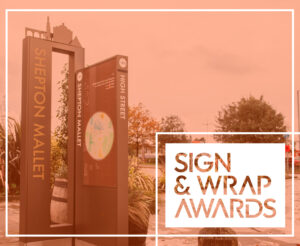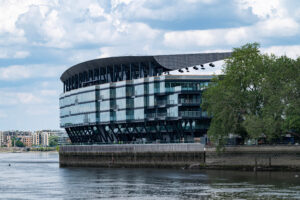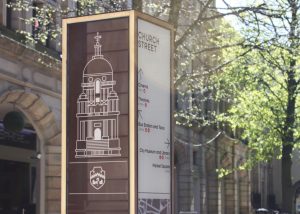What does it mean to ‘Go Green’ and how can wayfinding help?
When we think about “greening” a city, what springs to mind? Is this about tree planting? Electric vehicles? Or is there something else to it?
It’s the topic of conversation at the Forum for the Built Environment (fbe) event this month, which we are very much looking forward to being part of.
Throughout 2022, fbe has been exploring innovative solutions to our global climate crisis. And as fbe focusses on the value of green infrastructure in our towns and cities, we are thinking about how wayfinding can contribute to the discussion, and the solution.
Going “green” means more trees
Cars and concrete have dominated our cities for decades, but now the tides are turning. Cities up and down the UK are reclaiming space from tarmac and giving it to tree planting.
And it’s not just trees.
Planting of all shapes and forms can have numerous health and environmental benefits for our cities. Beyond their aesthetic value, planting mitigates the urban heat effect and reduces flash flooding from surface run off. Trees clean our air, provide welcome shade and stabilise soils. And, above all, trees combat our carbon dioxide emissions, helping to address climate change.
Not only is there an obvious environmental benefit, but open space has proven mental and physical health benefits, provides recreational opportunities and brings communities together.

Undoubtedly, bringing green spaces into our cities is invaluable and a critical piece in the puzzle to achieving “greener” cities.
Manchester has oft been criticised for its lack of city centre public open space. We can do bold planting well (who doesn’t love the striking Paulownia tomentosa trees in St Peter’s Square with their violet foxglove-shaped blooms?) but greening Piccadilly Gardens is proving a more difficult conundrum.
However, change is coming. Manchester is finally getting its first ever city centre public park, at the Mayfield redevelopment site, south of Piccadilly Station. Hugely overdue, Mayfield Park will undoubtedly draw in crowds, a sign of just how valued green open spaces are to city dwellers.
Wayfinding in cities can be crucial to the success of new green spaces like Mayfield Park. Our work often aims to use green and open spaces as natural points of orientation, so in cities it’s important to highlight the pocket parks and hidden breathing spaces. Our work at Circle Square, for example, highlights the green space that is hidden from the main thoroughfare of Oxford Road. In Ireland, our Blueways project will help deliver interpretation trails along and around Ireland’s canal network, helping users to navigate and give them the confidence to explore the greener routes and less built up pathways.
And beyond the critical navigational aspect, wayfinding strategies also focus on the branding of a new space to reinforce its identity and create a sense of destination, to reinforce the new neighbourhood’s identity and to let people know they’ve arrived.
Going green also means less cars
But, of course, there is another way our cities can “go green”.
There is a revolution taking place within our towns and cities. We are slowly but surely turning our backs on the private car.
So many of the UK’s cities expanded in the age of the motorway, and are shaped by a reliance on the car. The dominance of the Mancunian way, and the resultant effect it had of segregating neighbourhoods like Hulme from the city centre shows that Manchester is no different.
But now, with a renewed appreciation for active travel, and with some careful masterplanning and coordinated cross-departmental thinking, local decision makers are giving space back to people and bicycles.
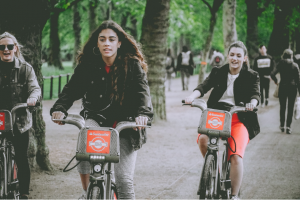
We love the vision of Manchester’s Bee Network to create a comprehensive network of segregated cycle and walking routes making it easier and safer to choose active transport.
Not only will this approach reduce carbon emissions and improve air quality, but giving people priority over cars fundamentally changes the feel of a place. We get to slow down, explore and interact with a place without the barriers that cars bring.
At Swansea, the wayfinding strategy incorporated a digital cycle map to help users plan their journey and break down the barriers to choosing active travel.
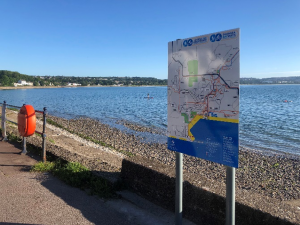
The best solutions combine the two
Wayfinding is a unique built environment specialism that works alongside masterplanners, landscape architects and architects. From our vantage point, we get to combine the benefits of both aspects of “going green”: by bringing together our understanding of what makes a place special with our graphic design capabilities we help reinforce a sense of place and encourage active travel in our towns and cities.
In Berewood, Hampshire, a comprehensive masterplan incorporates green and blue networks from the outset, with the dual aims of enhancing existing flora and fauna and encouraging people to choose active travel. When places and spaces are easy to navigate, people are more likely to leave their cars at home. And not only does the project encourage active travel, the green aspects have elevated the neighbourhood so that it is a truly distinctive and desirable place to visit, not just “another” housing development.


Going green is critical for the environment
It’s clear that turning our cities green is absolutely critical to combatting our climate crisis.
The good news is that there is plenty of opportunity to “green” a city, whether that’s through incorporating new areas of green, open space or designing in segregated active travel routes.
In Manchester alone, we are seeing fantastic, innovative solutions to incorporating new green infrastructure into our urban environment. From Mayfield Park, to Victoria North and the Castlefield Viaduct, there is plenty to take inspiration from, and with Manchester’s rich and historic urban fabric, there is plenty of opportunity for more.
Join the discussion about Manchester’s latest “greening” schemes at fbe’s Greening the City event on 12 July. And get in touch with us on 0161 241 3174 if we can help you in your ambitions to green your place and bring in opportunities for active travel.


